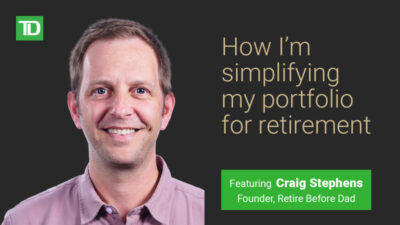How I’m Simplifying my Portfolio for Retirement
 TD Bank interviewed me on this topic. Check out the interview on YouTube or below.
TD Bank interviewed me on this topic. Check out the interview on YouTube or below.
I’m 48. It’s been 28 years since I invested in my first stock.
Twenty-eight years from now, I’ll be 76, about the same age as my parents.
My parents recently fired their financial advisor and asked me to assist in managing their retirement portfolios.
That might seem like a massive responsibility, but it didn’t feel that way.
After many years of investing and writing about personal finance, I knew exactly how to invest the money — simply.
The exercise of allocating a portfolio from scratch into a simple, age-appropriate, low-cost ETF portfolio made me reevaluate my own investment portfolios.
I asked myself: Does my portfolio today look how I want it to look in 10, 20, and 30 years?
The answer is no. So, I’ve been thinking about how to transition from today’s portfolio to a less complex portfolio tomorrow.
Table of Contents
Contributing Factors
Investing has always been a fulfilling hobby. Over the years, my interest in stocks, portfolio building, and tax avoidance has been like a professional passion that my IT career couldn’t satisfy.
Stock research became a career escape.
During breaks and downtime at work, I’d find ways to absorb what was happening in the markets. At night, I’d research stocks and plan my portfolio.
That led to writing online. When I first started blogging in 2013, I was building a dividend stock portfolio to provide income to support my lifestyle when I retired.
But I became less interested in writing about individual stocks and more inclined to write about broader financial topics with my own twist.
Parenthood and career advancement gradually became more thirsty for my time and brainpower, reducing my daily surplus of intellectual capacity.
With the time and capacity left over, I gravitated toward writing and running my business and away from individual stock research.
When I finally left my career to write full time, I no longer needed an escape.
Now, I mostly buy ETFs.
My combined investment portfolios still have about 60 individual stock holdings from 25+ years of investing.
These individual holdings complicate my portfolios and require me to spend time monitoring company news and earnings.
I want the portfolio of tomorrow to require less of my time so I can focus on retirement leisure, especially while traveling abroad. There’s also a benefit for estate planning purposes. I don’t want to leave a mess if I die early.
During the decades I was building my investment portfolio, I always assumed I’d want to continue researching stocks forever.
Today’s reality tells me that’s no longer true.
No Urgency
The transition from today’s portfolio to tomorrow’s will be gradual. Selling 50 stocks in a taxable account all at once would cause significant tax consequences.
Instead, the process will be slow and deliberate.
The approach is to reduce individual holdings and consolidate investments into diversified funds and ETFs while maximizing tax efficiency.
I am still comfortable with my taxable portfolio and have no regrets about building it. We’re living off dividends, and we pay no taxes on the income because we fall below the income tax thresholds now that I’m self-employed.
However, I’m seeking tax-efficient opportunities to swap individual holdings for dividends or total market ETFs. Namely SCHD and VTI.
I’m swapping out underperforming stocks with limited capital gains and dividend growth potential.
For example, I recently sold Hasbro (HAS) and Flower Foods (FLO) and bought SCHD with the proceeds. Both have paid reliable dividends but far underperformed other holdings and the market.
Both sales caused limited tax consequences because the stocks were flat for so long.
I replace higher-yielding stocks with SCHD and lower-yielding stocks with VTI to minimize disruption to my dividend income stream.
Twenty-one stocks in my taxable portfolio have increased more than 100% since I acquired them. That’s a nice problem to have.
I can offset gains from winners when I sell the losers. I’ll take advantage of a lower tax bracket while I can and accept small tax consequences as I transition to a simpler portfolio.
There’s a long way to go. But if I can reduce the portfolio by a handful of stocks yearly for the next ten years, I’ll have the portfolio down to a more manageable number of holdings when I hit 60.
My ten-year taxable account target portfolio is around twenty stocks or less and five to seven ETFs.
On the Retirement Side
Another simplification goal is to reduce the number of our retirement accounts and consolidate the holdings.
Most of our family wealth is in IRAs transferred from employer-sponsored savings plans dating back to 1998. These are easier to modify because dividends and capital gains are not subject to tax consequences.
I can modify the portfolios as I wish, and I’ve already done so to some extent.
I use Fidelity mutual funds in these accounts, some of which I’ve owned since my first job. One managed fund is up more than 1,000%
The rest is in index funds and a few individual growth stocks — 90% stocks and 10% bonds.
My retirement portfolios follow the same idea as the taxable ones:
- Reduce holdings
- Swap individual stocks for index funds
- Take a more laissez-faire approach
I have four retirement accounts (IRA, Roth, 403(b), and 401(a)), and I intend to transfer the former employer accounts into the IRA when the time is right. That would reduce my number to two (and Mrs. RBD has two).
The employer accounts lack a total stock market fund (like FSKAX), so I must combine multiple funds to get the allocation I want. Once transferred, I can consolidate.
At this stage, it’s unlikely I’ll ever return to my former employer. But if I ever do, closing the 403(b) and 401(a) would complicate restarting the employer match (according to documents I read when I left).
It’s a great company, and I would return under certain circumstances. I’m keeping that door open for now, just in case.
Adjust as Needed
I have no regrets about what my portfolio looks like today. I spent an extraordinary amount of time building it over the years and enjoyed that. My portfolios have performed well, and I’m now living off the dividend income tax-free.
But my portfolios have never been perfect. I’m not a perfectionist, and getting things to “perfect” would have taken even more time.
I’m constantly reevaluating, which has landed me where I am today, though today’s plan could change again in a few years.
Now that I’ve cut back on stock research time, I’m not eager to return. My writing business takes most of my attention now, and I enjoy it more.
Ironically, I research and write about emerging businesses for my other website, but that research and writing style is much different than public stock research.
When I fully retire and start traveling more, I can imagine still reading the daily business news (smartphones are great) but not spending the time required to manage a complicated portfolio.
I expect to crave more simplicity. I already do.
My parent’s retirement portfolios are in a good place — indexed and diversified. But my Dad still owns about a dozen individual stocks in a taxable account. We sold some last year to prepare for the house purchase.
But most of his stocks are far above his cost basis. Since he doesn’t need the money, we are comfortable holding them longer, as all of them are blue-chip dividend stocks that don’t require much research and maintenance. He’s on top of it.
In the next few years, we’ll be strategic and opportunistic with his taxable portfolio. We’re automatically reinvesting his dividends into SCHD instead of the stocks he already owns. Much of his money is already in high-yield savings and short-term Treasurys.
And he has something I’ll never have: a pension that covers their living expenses. This allows him to take a bit more risk with his investment accounts because he does not need to withdraw funds immediately, except for required minimum distributions (RMDs).
I’ve always viewed my investment activities as building a personalized pension. That doesn’t change with simplification.
Online Webinar Thursday, March 14th, 2024
If you liked this article, TD Bank featured me in an interview on the topic in a free webinar on Thursday, March 14th.
Thanks to those of you who joined. Here’s a video recording of the conversation.
Featured photo via DepositPhotos used under license.

Craig is a former IT professional who left his 19-year career to be a full-time finance writer. A DIY investor since 1995, he started Retire Before Dad in 2013 as a creative outlet to share his investment portfolios. Craig studied Finance at Michigan State University and lives in Northern Virginia with his wife and three children. Read more.
Favorite tools and investment services right now:
Sure Dividend — A reliable stock newsletter for DIY retirement investors. (review)
Fundrise — Simple real estate and venture capital investing for as little as $10. (review)
NewRetirement — Spreadsheets are insufficient. Get serious about planning for retirement. (review)
M1 Finance — A top online broker for long-term investors and dividend reinvestment. (review)


Craig, if your income remains below the threshold for paying taxes on dividends, why not keep the dividend paying stocks? If you die before your wife, she would get the stepped-up basis. Likewise, when she passes, your beneficiaries would get the stepped up basis as well. Meanwhile, you could continue to receive the dividend income.
I will keep some stocks, just not all of them. The idea is to swap some stocks into ETFs so I have fewer stocks to monitor. The ETFs will pay dividends too. At this point, the dividends should stay at about the same level. But the total income threshold may not last. I will take advantage of it while I can.